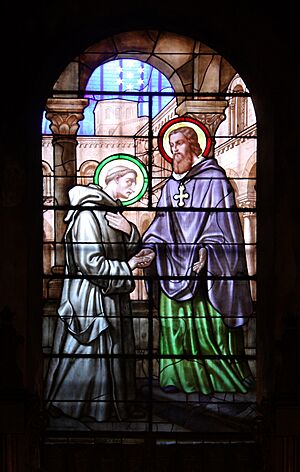Hugh of Châteauneuf facts for kids
Quick facts for kids SaintHugh of Châteauneuf |
|
|---|---|

Painting from the Carthusian cloister of Nuestra Señora de las Cuevas by Francisco de Zurbarán. The scene depicts Saint Hugh in a Carthusian monastery.
|
|
| Bishop of Grenoble | |
| Born | 1053 Châteauneuf-sur-Isère, County of Albon, Holy Roman Empire (in modern France) |
| Died | 1 April 1132 Grenoble, County of Albon, Holy Roman Empire |
| Venerated in | Catholic Church |
| Canonized | 22 April 1134, Rome, Papal States by Pope Innocent II |
| Feast | 1 April 22 April (Carthusian Order) |
| Attributes | Lantern, three flowers |
| Patronage | Grenoble, headache sufferers |
Hugh of Châteauneuf (in French, Hugues de Châteauneuf), born in 1053 and passing away on April 1, 1132, was a very important religious leader. He is also known as Hugh of Grenoble. He served as the Bishop of Grenoble from 1080 until his death. He was a strong supporter of a church reform movement called the Gregorian reform. He also had disagreements with the Archbishop of Vienne, who later became Pope Callixtus II.
Hugh's Life Story

Hugh was born in Châteauneuf-sur-Isère, a place in what is now France. His father was Odilo of Valence. From a young age, Hugh showed deep religious devotion and a strong understanding of religious teachings. Even before becoming a priest, he was made a canon in Valence. People said he was so devoted that he barely noticed anyone outside his religious duties.
In 1080, at a meeting called the Council of Avignon, Hugh was chosen to be the bishop of Grenoble. He was not yet a priest, but the church in Grenoble was in a very bad state. Hugh was picked to help fix it and bring it back to the strict rules of the Gregorian reform. A special messenger from the Pope took Hugh to Rome. There, Pope Gregory VII himself made Hugh a priest and then a bishop.
When Hugh returned to Grenoble, he immediately started working to fix the problems in his new area. After two years, he had done a great job. He had stopped many bad practices and helped people become more religious. He even tried to give up his bishop role and join a Benedictine monastery. But the Pope told him he had to continue his important work as a bishop.
For the rest of the 11th century, Hugh's time as bishop was challenging. He had conflicts with Count Guigues III of Albon over church lands in the Grésivaudan valley. Hugh believed the Count had taken these lands unfairly from the bishopric of Grenoble. They finally reached an agreement in 1099. The Count agreed to give back the disputed lands. In return, Hugh accepted the Count's power in the area around Grenoble.
Hugh also played a key role in starting the Carthusian Order. In 1084, he welcomed Bruno of Cologne and six friends. Hugh had a dream where he saw them under a banner of seven stars. He settled these seven men in a cold, rocky mountain area called Chartreuse. They built a monastery there and dedicated their lives to prayer and study. Hugh often visited them and was said to adopt many of their simple ways of life. Hugh also founded the nearby Monastère de Chalais, which later became its own religious order.
Hugh's Legacy
Hugh was declared a saint, a process called canonisation, on April 22, 1134. This happened only two years after his death. Pope Innocent II made him a saint. His special day, or feast day, is celebrated on April 1 in the Catholic Church. During the French Wars of Religion, which were conflicts between Catholics and Protestants, Hugh's body was sadly burned by Protestants.
A church in Rome, called Sant'Ugo, was named after him in 1991. There is also a church named after him in Greenbelt, Maryland, in the United States.
See also
 In Spanish: Hugo de Grenoble para niños
In Spanish: Hugo de Grenoble para niños

